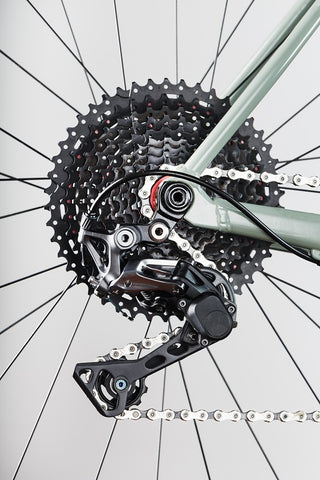How to Choose the Right Gear Ratio for Your Ride
Cycling, at its core, is a dance between man, machine, and terrain. However, to enjoy the rhythm of this dance, it's crucial to understand the notes and nuances that play in the background—the bike's gear ratios. As any seasoned cyclist will attest, knowledge of these gear ratios can profoundly impact your cycling experience, from the speed you attain on a straight road to the ease with which you climb a steep hill. This guide delves into the intricate details of the bike's gear system, demystifying it for both beginners aiming to set out on their cycling journey and veterans looking to further refine their ride.
Introduction to Bike Gear Systems
The heart of every bike lies in its mechanical system—specifically, its chain set and cassette. When you look closely, these aren't just amalgamations of metal, but carefully designed systems that dictate how your bike responds to every pedal stroke.
The chain set, often located at the front, typically comprises the chainrings, the crank set, and more often than not, a derailleur. This system can vary in complexity. Some bikes sport a simple single chainring, making for a straightforward gear choice. Then, there are bikes with two chainrings—aptly named doubles. These are particularly common in road bikes, offering a balance between speed and versatility. And for those who desire a broad range of gear choices, there are triples, boasting three chainrings. These are more common in mountain bikes and touring bicycles, where varying terrains demand a wider array of gear options.
Now, as you move to the rear, you encounter the cassette. Picture it as the counterpart to the front's chain set. Modern cassettes often comprise 10-11 cogs, but advancements in cycling technology have seen numbers ranging from 8-12. Remember, each cog plays a pivotal role. The largest cog, snuggling close to the spokes, represents the easiest or lowest gear. This is your best friend when climbing daunting hills. In contrast, the smallest cog, positioned nearest to the frame, stands as the hardest or highest gear, ideal for those moments when you're chasing the wind on a downhill or flat stretch.
Understanding Gears and Their Differences
With the basics in place, let's delve a bit deeper. Every gear, be it in the chain set or the cassette, is distinguished by the number of teeth it has. Imagine a bike with a 52-tooth bigger ring and a 36-tooth smaller ring. These numbers aren't arbitrary; they define how your bike reacts to different terrains.
The cogs in the cassette follow a similar logic. Each individual cog has a set number of teeth, and this number dictates the ease or difficulty of pedaling. But the magic truly unfolds when you combine the front and rear gears.
Enter the realm of gear ratios. Consider a scenario where you've selected a 52-tooth front gear and paired it with an 11-tooth rear. Crunching the numbers, you get a ratio of 52/11, which is approximately 4.72. In layman's terms, for every complete revolution of the pedals, the rear wheel will turn 4.72 times. This is crucial because the gear ratio directly affects your cadence—the rate at which you pedal. Higher ratios often mean more speed but require more effort, while lower ratios offer ease but at a slower pace.
In essence, the dance between the chain set and cassette is a delicate one. The combination of gears you choose can either make your ride feel like a breezy waltz or a challenging tango.
Selecting the Right Gears for the Terrain
One of the joys of cycling is the diverse range of terrains it offers, from the heart-pounding thrill of downhill runs to the challenge of steep mountain climbs. It's in these varied conditions that the importance of selecting the right gear ratio becomes evident.
For those flat, fast stretches, high gear ratios are your ally. When cruising on a level surface, you'd naturally want to cover more ground with each pedal stroke, and that's where a larger chainring combined with a smaller cog comes into play. It might demand more effort, but the payoff is speed and distance.
Conversely, when facing a daunting uphill climb, lower gear ratios are the savior. Steep terrains necessitate ease over speed to maintain a high cadence without exhausting the rider. That's when smaller chainrings at the front combined with larger cogs at the back become vital. They allow for steady, manageable pedal strokes, ensuring you conquer that hill without depleting all your energy.
It's also crucial to consider the transition between terrains. Anticipating changes helps in pre-selecting the most efficient gear. Before a steep ascent, shift to a more comfortable gear ratio ahead of time. It prevents those jarring moments when you're caught off-guard, struggling to maintain rhythm.
Lastly, remember that weather can also influence gear choices. Wet conditions might make certain inclines more slippery, requiring a more controlled approach with a lower gear ratio. On the other hand, a strong tailwind on a flat road could be an excellent opportunity to shift to a higher gear and enjoy the push.
Customizing and Personalizing Your Gear System
While the basic principles of gear ratios remain consistent, cycling is a deeply personal experience, and what works for one rider might not work for another. This is where customization and advancements in cycling technology come to the forefront.
Starting with the chain set, swapping out chainrings provides a chance to fine-tune your experience. Perhaps you live in an area dominated by hills and valleys; a smaller chainring might be more appropriate. On the other hand, if you're in a region with vast stretches of flatlands, a larger chainring could serve you better, offering higher speeds.
As for the cassette, technological innovations have expanded the options available to cyclists. Gone are the days when an 11-speed was the pinnacle of advancement. Today, 12 or even 13-speed groups are on the market, catering to an even broader range of terrains and cycling requirements. The benefit? More cogs mean smaller jumps between gears, allowing for smoother transitions and a more fluid cadence.
Furthermore, for those keen on smoother gear changes, the evolution of electronic gears, like the Di2, is a boon. Not only do they offer precision, but they also prevent overly aggressive gear combinations, ensuring that your chain remains in optimal condition and the angle is always efficient.
Lastly, regular maintenance cannot be emphasized enough. Ensuring your chain is well-lubricated, especially considering weather conditions, can drastically affect your gear changes. A well-maintained bike not only offers smoother shifts but also prolongs the life of each component, ensuring that your personalized gear system remains in top condition ride after ride.

Advanced Gear Maintenance and Techniques for Optimal Performance
Even after perfecting the art of selecting the right gear ratios and customizing your bike, there's one final frontier to master: advanced gear maintenance and efficient shifting techniques. These factors can significantly elevate your riding experience.
Firstly, a close watch on the chain's angle when riding can save you from potential wear and tear. Aggressive chain angles, arising from mismatched gear combinations like using the 53 ring at the front with a 28 at the back, can strain your setup. Smooth transitions, such as shifting the front gear first and then adjusting the rear cassette, ensure a fluid rhythm that doesn't jolt you out of your cycling flow.
For those looking to up their game, being proactive rather than reactive can be a game-changer. For instance, before approaching an intense climb, pre-emptively change to the required gear. Not only does this ensure a seamless ascent, but it also conserves energy by preventing last-minute, forceful gear changes.
Another critical aspect to remember is the pressure exerted on the pedals during gear changes, especially when shifting between the big and little rings. Reducing force during this transition minimizes the risk of dropping the chain or causing undue stress to the mechanism. Sometimes, it might even be beneficial not to shift gears, especially at the peak of an intense effort. A shift can momentarily reduce the force on the pedals, affecting your momentum.
Lastly, never underestimate the importance of regular bike maintenance. A well-lubricated chain ensures smoother gear changes, while monitoring the chain for signs of wear can prevent potential mishaps. Be it the occasional rainfall washing off the lubricant or the natural wear and tear, using weather-appropriate products and timely replacements can make all the difference.
Further Reading:
- Comprehensive Guide to Cycling Safety on the Road
- Pedal Power: The Rise of E-bikes and Their Place in Modern Cycling
- The Mental Benefits of Long-Distance Cycling
Conclusion
Understanding and selecting the right gear ratio is not just about the technicalities; it's about harmonizing with your bike to elevate your riding experience. From the basic principles of gear ratios to advanced maintenance techniques, the journey to mastering the gears is a continuous learning process. By personalizing your setup, anticipating terrains, and regularly maintaining your bike, you not only ensure optimal performance but also forge a deeper bond with your beloved ride. Remember, it's not just about the destination, but the joy of the journey – and the right gear can make it all the more memorable.











